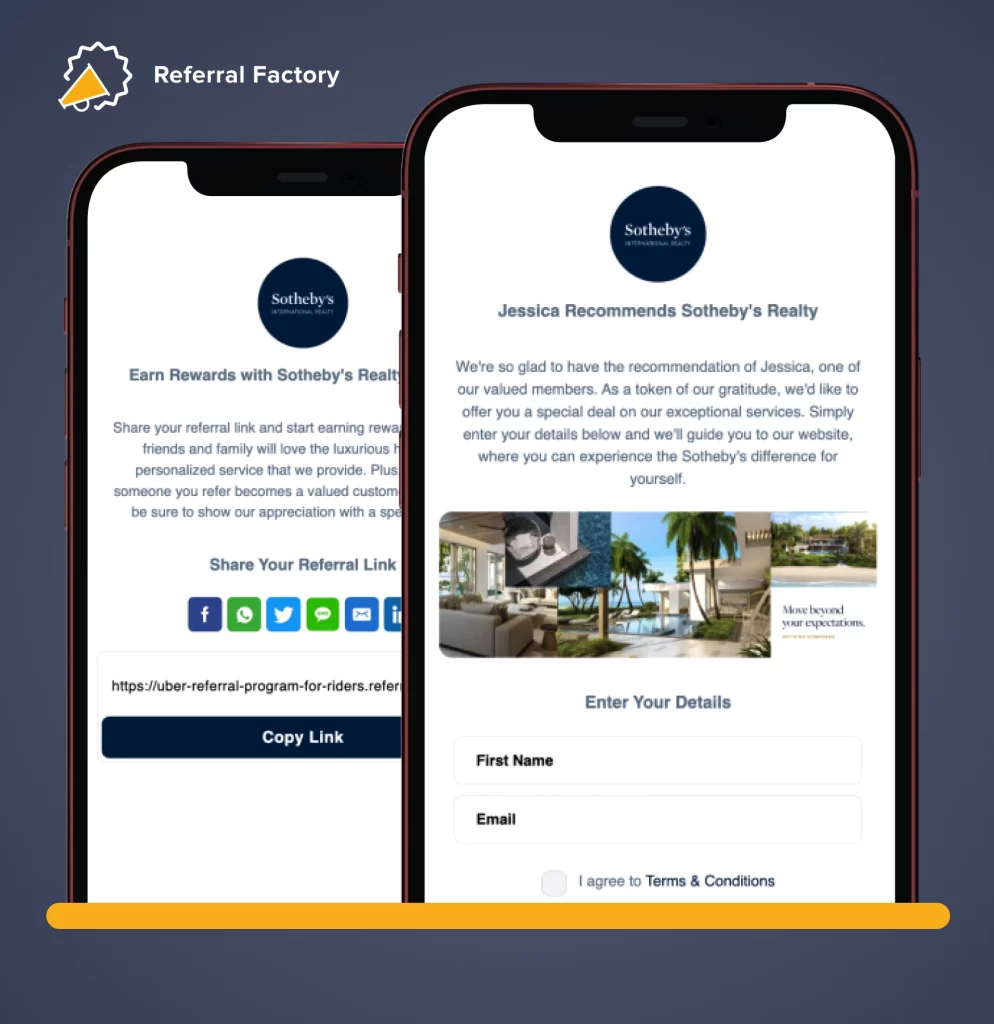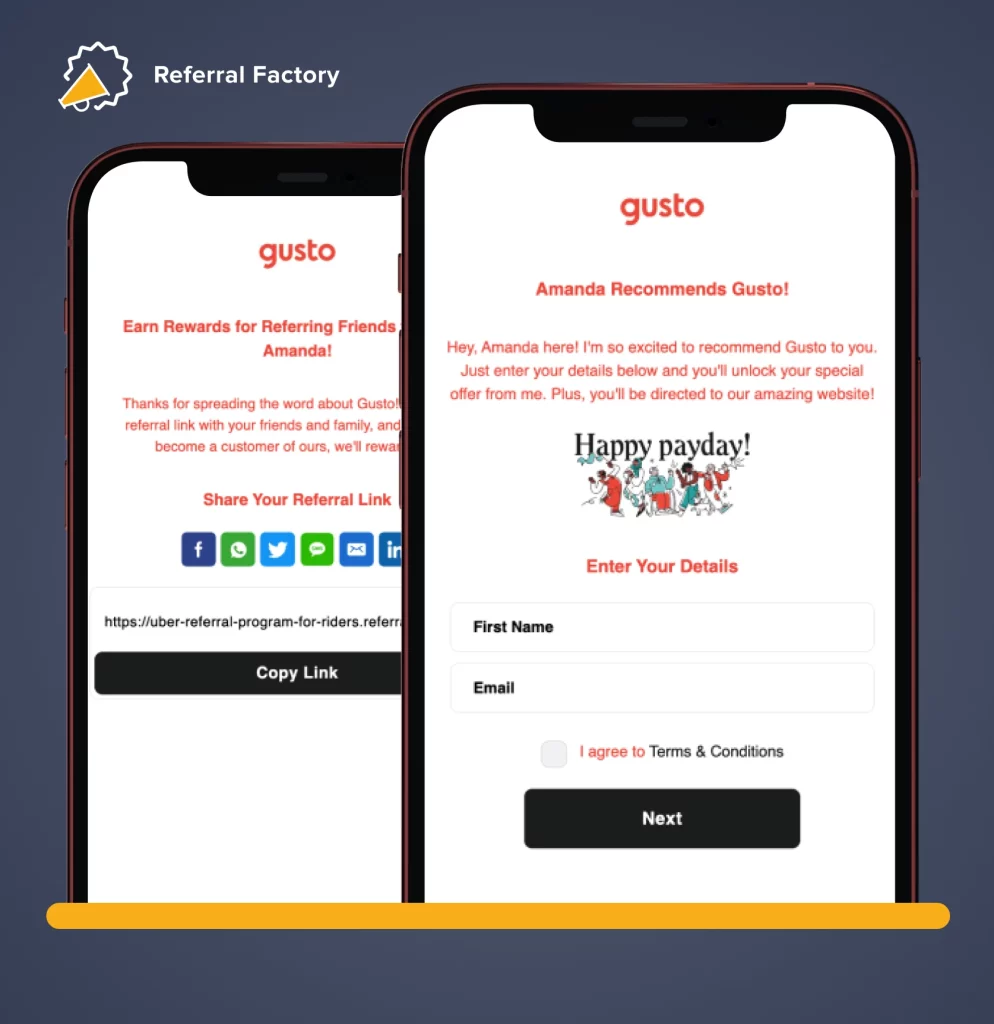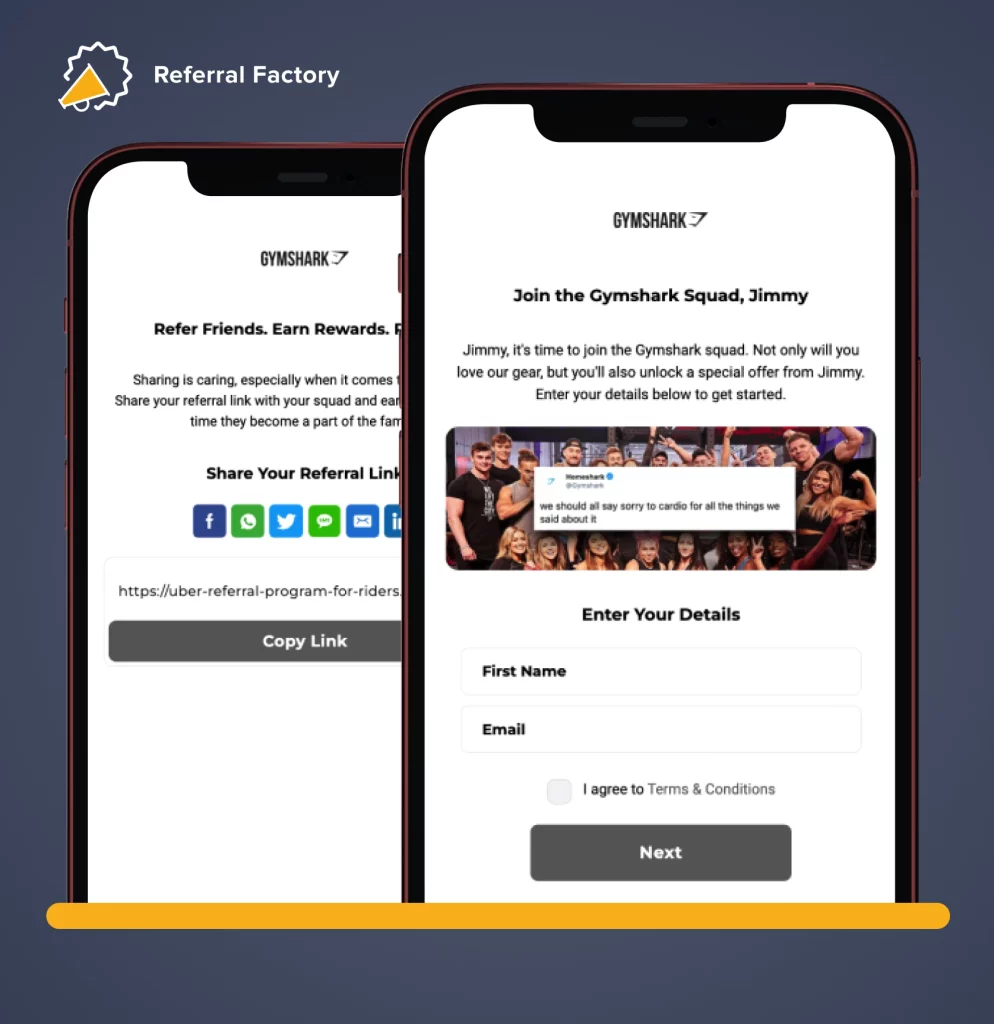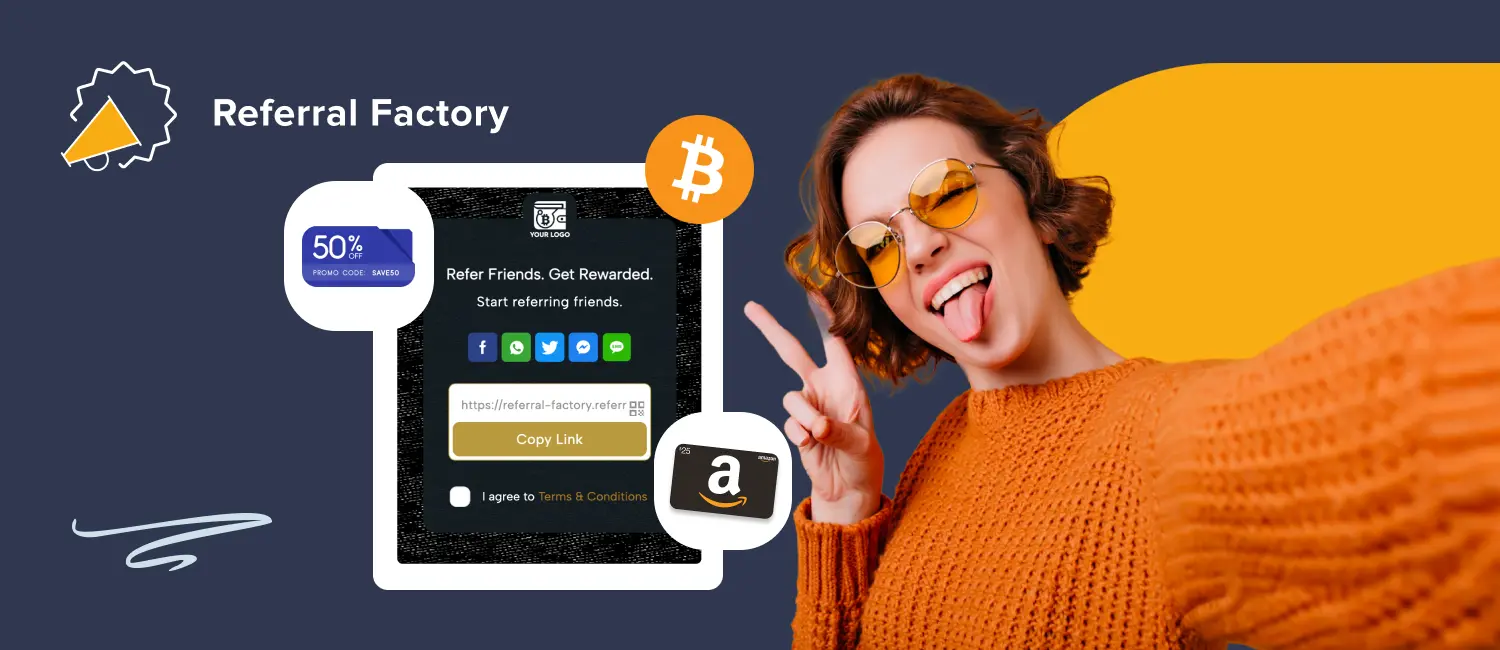How to Launch A Referral Program Successfully
As a business owner, you’re always on the lookout for new ways to grow your customer base. One effective strategy to achieve this is by launching your own customer referral program. Get more referrals by incentivizing your existing customers to refer their friends and family to your business, you can generate new leads to help you grow your business in a sustainable way.
Generate Referral Links for your customers, affiliates, ambassadors, and employees at the click of a button. of a button.
Table of Contents
Why you should launch a customer referral program
It could be argued that starting a business is easy. In most countries, the process of registering a business can be done in a couple of hours at a minimal cost. Moreover, there are over 1 00 000 domains registered online every day as more and more people purchase digital real estate as a signal that their business idea is coming to life.
This sounds great… until you realize that this is driving customer acquisition costs through the roof in most categories.
What used to cost $200 to acquire a customer five years ago now costs north of $500 to acquire the same customer. Pair that with the fact that customer willingness to pay for features and services has dropped drastically over the same period of time and, well, your expenses go up while your profitability goes down.
Not a good combo.
That’s why more businesses are going old school. Looking for ways to generate word of mouth and ultimately – turn one customer into two.
This is why we’re seeing a spike in businesses launching referral programs. It allows you, quite simply, to turn one customer into two.
Launching a referral program prompts your current customers to spread the word about your business, and earn rewards and incentives for doing so. And with referral software like Referral Factory, it’s easier than ever to build, launch, and manage a referral program without a developer.

When is the right time to launch a customer referral program?
Let’s face it, we’re all busy. One marketing campaign after the next. That’s why it’s important to ensure your business is ready to launch a referral program. Make sure it’s the right time so you can maximize your efforts and be sure you’ll get a positive ROI. (But, if you want a sneak peak right now – enter your business website below, and we’ll use AI to auto generate the perfect referral program for your brand. Create a referral link in seconds.)
We compiled this list of considerations to help you make a choice as to whether your business is ready for a referral program. It’s important to start with the fact that every business starts with an organic referral program from inception. As a business owner, you start as the first customer for your product or service. You then start referring others to use your product or service in order to get customers. As a matter of fact, your business already has a referral program. It just hasn’t been automated or optimized and you probably aren’t tracking its performance.
“With data for more than 28,000 Internet respondents in 56 countries, it has been seen that 92% of consumers trust recommendations from friends and family above all other forms of advertising.” – Source GOING VIRAL: THE EPIDEMIOLOGICAL STRATEGY OF REFERRAL MARKETING, SAYANTARI GHOSHA, 2018.
Any company regardless of size, industry, or life-cycle stage can have a successful referral program. We’ve just compiled these criteria for those wondering when may be the best time to start a referral program.
Do you have a great product or service?
It always starts with what you are trying to sell. Does it do what it says it should do on the box? You need to make sure that your product or service efficiently solves the customer’s problem. Bonus points if the process leaves the customer feeling delighted.
Think of it this way, how likely are you to recommend something to someone if your experience of that thing wasn’t great? Having a great product or service means happy customers. Happy customers are more likely to refer your product to others.
Make sure your product experience or service delivery are important to you, because this is the foundation of a great referral program. It’s the secret ingredient more marketing budget can’t buy.
Do you have existing customers?
While you were likely to be the first customer and referrer for your business if you own the business, you need more than yourself for it to be a viable business. The same applies to starting a referral program. The more customers you have the better you are able to take advantage of network effects where the value of your referral program increases the more existing customers you have.
While it depends on market factors and your price point, we suggest having at least 100 – 1000 existing customers to fully take advantage of a referral program. The lower the price, the higher the number of existing customers you should have.
Let’s compare the potential results of this spectrum.
If you have 100 customers.
You can expect 30 of those to refer customers.
You can expect 60 referred leads from those who choose to refer.
You can expect 18 of those referred leads to turn into existing customers.
If you have 20 customers.
You can expect 6 of those to refer customers.
You can expect 2 referred leads from those who choose to refer.
You can expect 1 of those referred leads to turn into existing customers.
As you can see having more customers results in better returns. But it’s important to highlight that you can still use the few customers you have to get more customers. A referral program creates a flywheel referral loop that grows your customer base while also compounding returns as your customer base grows.
Are your existing customers engaged?
It’s not just about the number of customers but also the quality of the customers and how engaged they are with your business. You can have thousands of social media followers and hundreds on your email list but if those people aren’t engaged with your brand then they won’t refer customers. Referral incentives aside, it takes more effort and time for a customer to refer other customers, and if they not opening your emails or following your social media then they are less likely to refer their friends. That makes engagement a great metric to consider before starting a referral program.
Below are some of the key engagement benchmarks to consider for primary digital marketing channels. They calculate the number of people that take a particular action (like sharing, opening, commenting or liking) as a percentage of the people that saw your content.

If you refer to your analytics for the platforms above and are in the range or above the benchmarks, that suggests you have an engaged audience which sets your referral program up for success.
Are you spending money on paid advertisements?
Platforms like Google, Facebook, and LinkedIn make their money primarily by offering advertising to reach potential customers. If you’re reading this article, it’s safe to assume that you’ve tried paid digital advertising to market your business and sell products or services.

The benefit of having used paid advertising is that if it’s done right it provides a benchmark for how much it costs to turn a potential customer into a paying customer. This is what we call Customer-Acquisition-Cost (CAC). When starting a referral program having this figure can assist in designing rewards or incentives. The general rule is that the monetary value of your rewards and incentives should be less than the cost to convert a customer when using paid ads.
For example: Let’s say it costs you $50 to convert a single customer through paid social advertising. Based on this you can reward someone who refers a new paying customer to you with $40. Better yet, you should have a double-sided referral that rewards the person who referred $20 and the new referred customer $20.
Knowing what it costs to convert someone gives you a great foundation on which to base your rewards and incentives. It’s also important to remember that your rewards don’t have to be monetary. Experiences and exclusivity are also great for rewards or incentives and can lower the cost of converting a customer through referrals even lower.
Do you use a CRM platform?

CRM stands for Customer Relationship Management and there are various software platforms available that help you business owners manage relations with customers. An investment in a CRM platform suggests that you have the ability build and nurture customer relationships, or that you have information on your customers to contact them. Most importantly, it suggests that you have existing customers who are engaged. There are all great signs that you’re ready to launch a referral program.
“Customer engagement is not a cost centre. It’s an invesment in customer relationships”.
Brian Solis
The next logical step after ensuring you deliver a great customer experience with a CRM platform would be asking those happy customers to refer their friends, so that you get new happy customers. This is where a referral program comes in.
If you plan on using referral marketing software to launch your referral program, make sure the tool you choose offers CRM integrations on ALL plans. The most common are HubSpot, Salesforce, Pipedrive, Intercom, Zoho, Stripe, Service Titan, Zapier, and more. This makes it easy to integrate your referral program into your existing workflows.
Launching a referral program if you’re using a CRM platform is a no-brainer. We’re preaching to the converted.
If you answer yes to any 3 of these 5 questions, then your business stands to gain a ton of value from launching a referral program. Whether you’re a business owner or a marketer trying to convince the board to start a referral program, these questions are great motivations for starting a referral program.

What type of rewards should I offer for a successful referral?
The type of referral rewards you should offer for a successful referral will depend on your business and your budget. You’ll first need to calculate how much you can (and are willing to) spend on a converted referral. When deciding on your budget, a good place to start is looking at your current cost per converted lead. This is the budget you have to play with. Remember that you should only be rewarding when someone’s referral is successful, meaning the lead they sent your way converted into a customer.
When deciding on your budget, the goal should not be to save as much as possible because you want people to feel motivated to refer their friends. You also notice that referred leads convert at a much higher rate (an average of 2x) than leads acquired through other online ads. This means if your reward is the same as your current cost-per-converted-lead then you’ll be able to get 2x more leads on the same budget!
Here are a few ideas to consider:
1. Discounts: Offer a discount to both the referrer and the new customer. This is a win-win situation and can encourage people to refer others to your business.
2. Gift cards: Give a gift card to the referrer once the new customer makes their first purchase. This is a tangible reward that people will appreciate.
3. Cash: Offer a cash incentive for each successful referral. This can be a bit more costly, but it’s a great way to motivate your customers to refer as many people as possible.
4. Exclusive access: Offer exclusive access to a feature or service that only referral customers can access. This can be a great way to make your customers feel special and valued.
5. Issue your own: platforms like Referral Factory make this easy, you get a neat dashboard that shows you who referred who and who needs a reward.

Ultimately, the type of reward you offer will depend on your business and what you feel will motivate your customers. Make sure the reward you choose aligns with your business values so that you attract the referrers (that will know the right kind of buyers).
Read our guide on calculating the value of a reward 👉 here.
What are some best practices for creating a referral program?
Referral programs are a powerful way to grow your business, increase revenue, and build a loyal customer base. But of course, it’s easier said than done. If you’re going to launch a referral program this year, then make note of these best practices so that you have the highest chance of success.
1. Keep it simple
Your referral program doesn’t need to be complicated, this just make it harder for you to manage and your users to engage with. Use simple mechanics like one referral = one reward, and communicate clearly what the reward is for the person referring and what the benefit is for the person invited. People will be more likely to refer their friends if they feel like they are sharing a killer offer with them, rather than selling your product to them.

2. Make it easy for users to refer and track their referrals
If your referral program is difficult to understand or navigate, people won’t bother. Keep it simple and make sure the process for referring someone is easy and straightforward. Use clear language on your landing pages and provide step-by-step pages to guide your customers through the process.

3. Choose the right referral program software
There are a variety of referral software tools available, so it’s important to choose the right one for your business. Look for a platform that integrates easily with your existing marketing stack and CRM, and also that offers features like tracking and reporting to help you measure the success of your program. Make sure there is an ability to easily issue your own reward, or that there are integrations with rewards partners (either native or through Zapier).
FULL, IN-DEPTH GUIDE: The Best Referral Software Tools To Use
4. Use referral links not referral codes
Make sure the referral software you choose offers a referral link generator [link to other blog] style flow – meaning users can either register to join your referral program, or you can auto generate referral links for your customers by uploading your contacts or syncing your CRM. By generating links, it means you can control what shows on these links – these links should open personalized invitation pages that let your customers offer their friends a perk for filling in their details. From here the person invited could be redirected to your own website or product. These pages are important because it acts as a lead warm up, and it also allows you to capture the person invited details in case they aren’t ready to buy today.

5. Announce and promote your referral program
Your referral program won’t be successful if nobody knows about it. You should constantly be promoting it on your website, social media channels, and in your newsletter campaigns. You should also send direct emails to your customer base announcing your referral program, so they know that it’s been launched and are aware of the incentives and how they can refer new business to you.

6. Follow up and say thank you – the personal touch most businesses forget
When someone refers business to you, make sure to follow up with them and thank them for the referral. Even if they already received a reward. This will not only show your appreciation, but it will also encourage them to refer more business in the future.
Creating a successful referral program takes time and effort, but the benefits can be significant. By following these best practices, you can create a program that incentivizes your customers to refer new business, while also building a loyal customer base and increasing revenue.
What software can I use to build my referral program

It’s a lot easier than you think to launch a referral program. You don’t need a team of developers anymore like you used to, or a growth-hacker to tie it all together, you just need fans and customers that are willing to spread the word.
If you have that, you can get a referral program up and running in a couple of days. There are also tons of great referral marketing templates you can copy, so look for one in your business category. Popular niches that use referral programs to grow are education, solar, finance (everything from tax advisory firms to fintech products), SaaS, crypto, home services businesses, fitness studios, yoga bars, retail brands, the list goes on.
Below we’ve included a breakdown of the top referral software on the market right now, ranked by their rating and online reviews across trusted sites like Capterra and G2. This shows what tools that are currently trending with real businesses just like you.

Inspiration: AI generated referral programs
We used an AI tool to auto-generate referral programs for some of the world’s most loved brands. The results are inspiring and showcase that if you have a great referral program, with a powerful message and enticing reward, people would more than likely participate because referral programs can be a lot of fun too.




Customers who love a brand are likely to refer it to their friends for many reasons, the reward is only one of them. Firstly, they may have had a positive experience with the brand’s products or services, and want to share that experience with others. People love sharing their lives with their friends, so if you have a positive impact on them it’s highly likely they will speak about your business in the future.
This can be especially true if the brand has exceeded their expectations in some way, such as by providing exceptional customer service or offering unique offerings that can’t be found elsewhere. Additionally, customers may feel a sense of loyalty or connection to the brand, perhaps because it aligns with their values and makes them feel like they have made good choices.
Finally, customers may simply want to help their friends find a solution to a problem or a need, and believe that the brand they love is the best option. Overall, customers who refer a brand they love are doing so out of a desire to help their friends, and share the same positive experience they had with their friends.
The reason adding a reward to your referral program is important because it sparks (and reminds) people to refer when they otherwise may not think of it. It encourages them to spread the word on social media, bring your business up in a Saturday night conversation with friends, and recommend you to their colleagues when the time is right. Offering a great reward makes people 4x more likely to refer you than they would have been before.
Why haven’t I heard of this before?
If you haven’t heard about referral marketing, that means you probably haven’t heard that consumers find word-of-mouth to be 2 to 10 times more reliable than paid advertisements. That’s why is easier to convert a lead from a referral than it is for any other marketing channel.
Either way, the good news is that you’ve heard the referral marketing message now, and you should have a clear understanding of how it can contribute to your overall growth goals.
Good luck launching your referral program!




